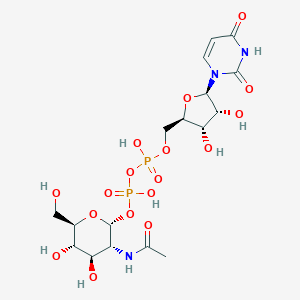| Synonyms |
Click to Show/Hide Synonyms of This Metabolite
(2R,3R,4R,5S,6R)-3-(Acetylamino)-4,5-dihydroxy-6-(hydroxymethyl)tetrahydro-2H-pyran-2-yl [(2R,3S,4R,5R)-5-(2,4-dioxo-3,4-dihydropyrimidin-1(2H)-yl)-3,4-dihydroxytetrahydrofuran-2-yl]methyl dihydrogen diphosphate (non-preferred name); (2R,3R,4R,5S,6R)-3-(Acetylamino)-4,5-dihydroxy-6-(hydroxymethyl)tetrahydro-2H-pyran-2-yl [(2R,3S,4R,5R)-5-(2,4-dioxo-3,4-dihydropyrimidin-1(2H)-yl)-3,4-dihydroxytetrahydrofuran-2-yl]methyl dihydrogen diphosphoric acid (non-preferred name); Acetylglucosamine, UDP; Diphosphate N-acetylglucosamine, uridine; Diphospho-N-acetylglucosamine, uridine; N-Acetylglucosamine, uridine diphosphate; N-[2-[[[5-[(2,4-Dioxo-1H-pyrimidin-1-yl)]-3,4-dihydroxy-tetrahydrofuran-2-yl]methoxy-hydroxy-phosphinoyl]oxy-hydroxy-phosphinoyl]oxy-4,5-dihydroxy-6-(hydroxymethyl)tetrahydropyran-3-yl]acetamide; Pyrophosphoacetylglucosamine, uridine; UDP Acetylglucosamine; UDP-Acetyl-D-glucosamine; UDP-Acetyl-delta-glucosamine; UDP-Acetylglucosamine; UDP-GlcNAc; UDP-N-Acetyl-D-glucosamine; UDP-N-Acetyl-delta-glucosamine; UDP-N-Acetyl-glucosamine; UDP-N-Acetylglucosamine; UDP-a-D-N-Acetylglucosamine; UDP-alpha-D-N-Acetylglucosamine; UDP-alpha-delta-N-Acetylglucosamine; UDPGNAc; UPPAG', Uridine 5'-diphospho-N-acetlyglucosamine, Uridine 5'-diphospho-N-acetylglucosamine, 'Uridine diphosphate N-acetyl-D-glucosamine; URIDINE-diphosphATE-N-acetylglucosamine; URIDINE-diphosphoric acid-N-acetylglucosamine; Uridine diphosphate N acetylglucosamine; Uridine diphosphate N-acetyl-delta-glucosamine; Uridine diphosphate N-acetylglucosamine; Uridine diphospho N acetylglucosamine; Uridine diphospho-2-acetamido-2-deoxy-D-glucose; Uridine diphospho-2-acetamido-2-deoxy-delta-glucose; Uridine diphospho-N-acetyl-D-glucosamine; Uridine diphospho-N-acetyl-delta-glucosamine; Uridine diphospho-N-acetylglucosamine; Uridine diphosphoacetylglucosamine; Uridine diphosphoric acid-N-acetylglucosamine; Uridine pyrophosphate 2-acetamido-2-deoxy-a-D-glucopyranosyl ester; Uridine pyrophosphate 2-acetamido-2-deoxy-alpha-D-glucopyranosyl ester; Uridine pyrophosphate 2-acetamido-2-deoxy-alpha-delta-glucopyranosyl ester; Uridine pyrophosphoacetylglucosamine; [[3-Acetylamino-4,5-dihydroxy-6-(hydroxymethyl)oxan-2-yl]oxy-hydroxy-phosphoryl]oxy-[[5-(2,4-dioxopyrimidin-1-yl)-3,4-dihydroxy-oxolan-2-yl]methoxy]phosphinate; [[3-Acetylamino-4,5-dihydroxy-6-(hydroxymethyl)oxan-2-yl]oxy-hydroxy-phosphoryl]oxy-[[5-(2,4-dioxopyrimidin-1-yl)-3,4-dihydroxy-oxolan-2-yl]methoxy]phosphinic acid
|
 click to show the details of this protein
click to show the details of this protein
 click to show the details of experiment for validating this pair
click to show the details of experiment for validating this pair
 click to show the details of this protein
click to show the details of this protein
 click to show the details of experiment for validating this pair
click to show the details of experiment for validating this pair
 click to show the details of this protein
click to show the details of this protein
 click to show the details of experiment for validating this pair
click to show the details of experiment for validating this pair
 click to show the details of this protein
click to show the details of this protein
 click to show the details of experiment for validating this pair
click to show the details of experiment for validating this pair
 click to show the details of experiment for validating this pair
click to show the details of experiment for validating this pair
 click to show the details of this protein
click to show the details of this protein
 click to show the details of experiment for validating this pair
click to show the details of experiment for validating this pair

